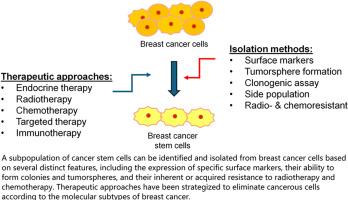Biomarkers, isolation methods, and therapeutic implications of breast cancer stem cells
IF 2.8
引用次数: 0
Abstract
Breast cancer metastasis and relapse remain uncontrollable despite significant advancements in early diagnosis and treatment, resulting in increased mortality. Breast cancer is the most frequently diagnosed cancer in women worldwide and has become the leading cause of cancer-related deaths. Cancer stem cells (CSCs) may play significant roles in tumor initiation, maintenance, invasion, relapse, metastasis, and therapy resistance. Although this small, highly heterogeneous, and restricted population of CSCs has been extensively studied, their cellular and molecular physiology remains unclear. Nonetheless, CSCs have increasingly become an attractive therapeutic target for combating advanced, treatment-resistant cancers. This necessitates the development of effective and reliable methods for their isolation and enrichment. This review provides an overview of the key characteristics of breast cancer stem cells (BCSCs) and illustrates their role in therapeutic resistance. Furthermore, it highlights various mechanisms underlying cancer cell adaptability and therapy-induced resistance across different breast cancer subtypes. The commonly used methods for BCSC isolation and identification are also discussed, as they could facilitate a deeper understanding of tumorigenesis, metastasis, resistance, and relapse, consequently contributing to the development of more effective therapeutic strategies for breast cancer.

乳腺癌干细胞的生物标志物、分离方法和治疗意义
尽管在早期诊断和治疗方面取得了重大进展,但乳腺癌的转移和复发仍然无法控制,导致死亡率增加。乳腺癌是全世界妇女中最常见的癌症,已成为癌症相关死亡的主要原因。肿瘤干细胞(Cancer stem cells, CSCs)可能在肿瘤的发生、维持、侵袭、复发、转移和治疗抵抗中发挥重要作用。尽管这个小的、高度异质的、有限的CSCs群体已经被广泛研究,但它们的细胞和分子生理学仍然不清楚。尽管如此,干细胞已日益成为对抗晚期、治疗难治性癌症的一个有吸引力的治疗靶点。这就需要开发有效和可靠的方法来分离和富集它们。本文综述了乳腺癌干细胞(BCSCs)的主要特征,并说明了它们在治疗耐药中的作用。此外,它还强调了不同乳腺癌亚型中癌细胞适应性和治疗诱导耐药的各种机制。本文还讨论了常用的BCSC分离和鉴定方法,因为它们可以促进对肿瘤发生、转移、耐药和复发的更深入了解,从而有助于开发更有效的乳腺癌治疗策略。
本文章由计算机程序翻译,如有差异,请以英文原文为准。
求助全文
约1分钟内获得全文
求助全文
来源期刊

Cancer pathogenesis and therapy
Surgery, Radiology and Imaging, Cancer Research, Oncology
CiteScore
0.80
自引率
0.00%
发文量
0
审稿时长
54 days
 求助内容:
求助内容: 应助结果提醒方式:
应助结果提醒方式:


